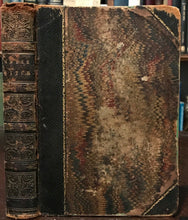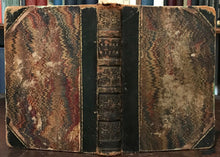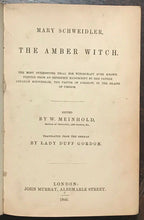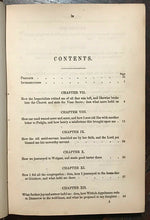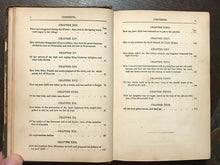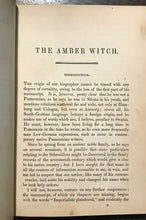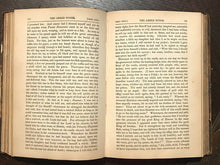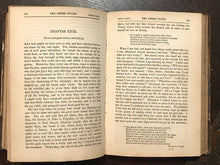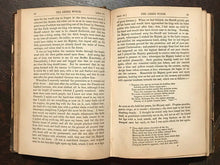1846 - THE AMBER WITCH - Meinhold - WITCH TRIALS WITCHCRAFT LITERARY HOAX OCCULT
Regular price
$225.00
Sale
Publisher: John Murray, London (1846)
Scarce early edition from 1846 of Mary Schweidler, THE AMBER WITCH. THE MOST INTERESTING TRIAL FOR WITCHCRAFT EVEN KNOWN. PRINTED FROM AN IMPERFECT MANUSCRIPT BY HER FATHER ABRAHAM SCWEIDLER, THE PASTOR OF COSEROW, IN THE ISLAND OF USEDOM. (Please see our other listing, for the first edition of this work.) Edited by Wilhelm Meinhold, and translated from the German by Lady Duff Gordon. Bound with "The French in Algiers". 176 pages in total. Marbled cloth boards with three quarter leather binding; marbled endpapers. The boards and binding are solid and tight; shelfwear to boards, with rubbed corners, spine and edges. Small bookbinder sticker on inside front board. Interior is unmarked save natural age-toning and foxing to endpapers. Please see below for more information on the fascinating history of this famous early 19th-century literary hoax.
***
"The Amber Witch" is a German novel published by Wilhelm Meinhold (1797–1851) in 1838. The novel was originally published as a literary hoax which purported to be an actual 17th-century chronicle. Meinhold later admitted to the hoax but had some difficulty in proving that he was its author. In 1844, it was published in Britain as THE AMBER WITCH, which was translated by Lucie, Lady Duff-Gordon and was first published as part of the literary collection for "The Home Library". Lady Duff Gordon's translation was very popular with the Victorians and went through numerous editions, including a luxury one in 1895 illustrated by Philip Burne-Jones. The novel was a favorite of Oscar Wilde's when he was a boy. In 1861 it was made into an opera, The Amber Witch, composed by William Vincent Wallace. Wallace's opera has faded into obscurity, but the novel on which it was based has continued to be republished, both on its own and in anthologies.
Meinhold claimed to have discovered a manuscript written by a 17th-century minister, Abraham Schweidler (purportedly a pastor of Coserow and known for his fire and brimstone sermons) amongst rubbish in the choir of the old Coserow church. The manuscript contained the story of the pastor's daughter Maria, the "Amber Witch". The tale was described by Meinhold, in the subtitle of the novel, as "the most interesting trial for witchcraft ever known". When it first appeared, almost all of the German critics believed it was an authentic historical document. The work attracted critical notice, not only for the dramatic nature of its narrative but also for disputes about which parts of it were original and which were Meinhold's reconstructions, written in imitation of the 17th-century style.
Meinhold's intention was to set a trap for the disciples of David Strauss and his school, who pronounced the Bible to be a collection of legends from historical research assisted by internal evidence In a direct challenge to these "modern documentary critics". Only in a later edition did the author admit that the tale was entirely imaginary. His admission that it was a hoax was at first rejected but was soon accepted as the truth...."The hoax was done with great skill and attention to detail, using language that would have been used in 17th-century Germany". (The Times 1840) Writer Seabury Quinn wrote an article in the August 1925 issue of Weird Tales in which, unaware of the hoax, he recounted the plot of The Amber Witch as if it were an actual historical event. -Wikipedia










